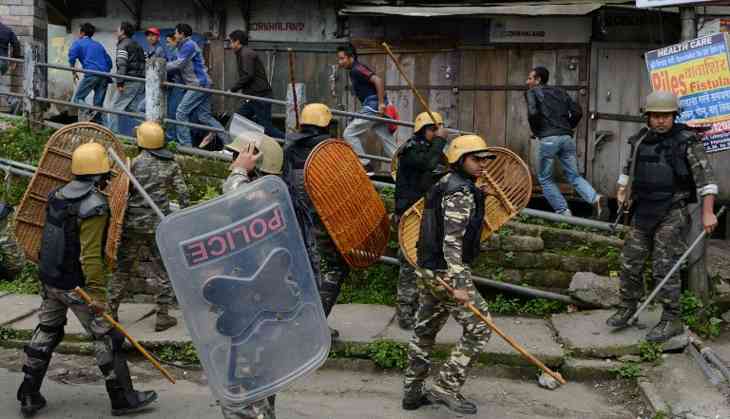The fire in Gorkhaland doesn't seem to be dying down anytime soon. Here's why

When Mamata Banerjee's cops raided Bimal Gurung's premises on Thursday the intent seemed to be clear: nip the problem in the bud.
But will the wily Bengal chief minister have her way in the land of 'two leaf and a bud'? Doesn't seem so.
Agitators showed a fresh resolve Friday morning against the state government. Also, several political observers do think otherwise.
Also read: The Darjeeling Tango: The result of equating apples with oranges
The crisis just seems to be worsening as the West Bengal government has refused to sit down with Gurung to discuss a resolution.
On 16 June, GJM workers burnt several government offices at Kalimpong and a panchayat office at Alipurduar as a protest against the government’s raid.
On the same day, other parties supporting the Gorkha cause, such as the Jan Andolan Party (JAP), decided to join hands with the GJM. The issue already had the support of the Gorkha National Liberation Front (GNLF).
To counter the GJM’s demand, the ruling All India Trinamool Congress (AITC) has already organised a rally at Mirik. In May, the party had won the Mirik Municipality board, securing six wards out of the nine.
On Friday, the Centre sent a letter to the state government mentioning that Bengal needs to send a report of the current situation in the hills as they cannot keep their forces for a prolonged period.
An ongoing crisis
According to several senior bureaucrats, the crisis may deepen if the state government does not sit down with the GJM to resolve matters. This discussion should happen in the ambit of the Gorkhaland Territorial Administration (GTA) agreement that was signed in 2011.
The agreement was signed during a tripartite meeting with the Centre, state government and the GTA.
And this agreement is one of two reasons why the Gorkhaland issue flares up every two years. The second reason is the presence of the Army in the hills.
As of now, the Centre is reluctant to let the state to resolve the situation as the Bengal police is not fully equipped to handle the situation.
“The state police does not have the adequate infrastructure to deal with this,” said an IAS officer posted in West Bengal who did not wish to be named.
Former chief secretary of West Bengal Ardhendu Sen said, “I don’t think sending police forces can solve the problem of Gorkhaland. The situation needs to be resolved by speaking with all parties under the GTA agreement. As the situation is aggravated at the moment, it is the duty of the Centre and the state government to sit and discuss it by convening a tripartite meeting, instead of taking aggressive ways to resolve the crisis.”
The stubborn truth
While the Centre has already declined to sit with the GJM over the issue, the state government has also shown its unwillingness. And this is perhaps what has forced the GJM to show its hand.
On 15 June, GJM general secretary Roshan Giri met with Home Minister Rajnath Singh, but Singh declined to entertain the demand for a separate Gorkhaland.
It may be mentioned that the agitation this time primarily broke out following the chief minister’s announcement that Bengali would now be compulsory in all state-run schools.
Later, the state government said that third languages would be made optional. But the government is yet to issue an official order in this regard. Gurung demanded that the CM should issue the order at the earliest but nothing has happened so far.
This led Gurung to change GJM’s demand and stick to asking for a separate state of Gorkhaland.
And this is not the first time that the demand has flared up. In 2013, after the new state of Telangana came into being, the GJM has called for an indefinite strike that continued for two months. During that time, the tourism and tea industry were affected badly.
Also read: We'll talk only if Gorkhaland is on the table: Roshan Giri, GJM
The IAS officer Catch spoke to said, “When Jyoti Basu was the chief minister, a similar situation occurred when Subhas Ghishing was the GNLF chief and GNLF had called for an indefinite strike. At that time, the state government deployed the CRPF and the BSF. But ultimately, the Centre withdrew the forces after some time.”
Amol Mukherjee a senior political analyst said and former professor of Presidency College said, “The situation in the hills may be aggravated, but a simple power grab by GJM isn’t going to solve anything. Although Mamata Banerjee has had time and energy to ensure that the hills are ‘smiling’, the government needs to resolve this crisis before it becomes more aggressive. The complaints of the ethnic groups need to be looked into before taking any stern decisions.”
With the Centre and the state not willing to discuss matters with the GJM and the CM not issuing an order regarding the Bengali language issue, the trouble does not look to be dying down any time soon.
First published: 17 June 2017, 15:49 IST
